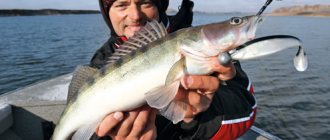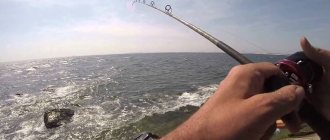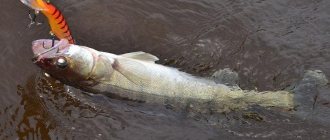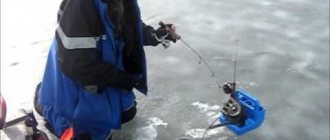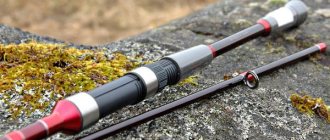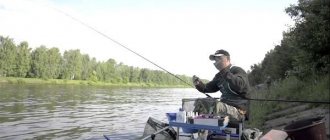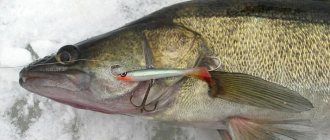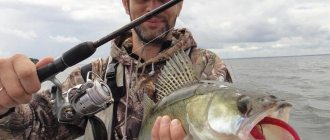The traditional way of catching predatory fish is by plumb fishing from a boat.
For a successful hunt, you need any watercraft, fishing gear and a set of artificial baits. One of the simplest and most effective ways to catch a predator is vertical fishing. The main problem that a novice fisherman will have to face is the mandatory presence of a boat. It could be a cheap rubber band with oars or a powerful boat with a gasoline engine. It is important that the craft is obedient to control, holds the chosen course well, and does not rotate under the influence of current and wind. That is why it is necessary to have on board such additional devices as a parachute bag, a rear rudder or a weight on a rope. In addition to the watercraft, the fisherman will need a fishing rod and a set of artificial baits.
The principle of vertical fishing
This method of catching a predator is quite simple. The craft is either anchored or floated slowly downstream or downwind. The angler lowers the bait into the water directly below the boat. By playing with a spinner or soft imitation, you can tempt a predator to bite. Since the fish is afraid of a boat above it, the minimum depth for fishing will be 3 m. The most effective fishing option is rafting down the river. When the wind blows in the same direction as the current of the river, the fisherman does not have to make efforts to give the boat a certain speed. As a result, it is possible to survey large areas of water, which has a positive effect on the catch. Sometimes schools of species such as pike perch or pike perch stand at a certain point. If you find a large concentration of fish, you should stop the boat and carefully examine the area. However, with search tactics, which seem preferable when hunting for pike, marking time reduces the chances of a good catch. Swimming too quickly also negatively affects the number of bites. That is why it is very important to select the speed of the boat, based on the characteristics of the reservoir and wind conditions.
Tackle for vertical lure fishing
For vertical lure fishing, traditional fishing rods are used, which are usually used for fishing during the freeze-up period. For fishing with jigs and small winter spinners, light winter fishing rods are used, although not balalaikas, but fishing rods with a long handle, a whip and an equally long nod. For fishing with heavy baits, it is best to use side fishing rods, short one-handed spinning rods, and fishing rods for winter trolling for pike perch. Sometimes they even use telescopic fishing rods with a side nod, removing extra elbows into the body to shorten the rod.
Fishing rod equipment
In the classic version, vertical fishing from a boat was carried out without a rod. The fisherman held a fishing line in his hand, at the end of which a homemade bait was tied. The effectiveness of fishing depended on skillful hand movements.
Modern fishing is carried out using a short fishing rod. It consists of the following elements.
- A short fishing rod up to 1 m long is best suited for vertical fishing from a boat. The tip of the rod should be rigid, and there may be 2-3 guide rings on the blank. It is convenient to hold the fishing rod with a cork handle.
- The tackle is equipped with any reel that can accommodate the required length of fishing line, allows you to quickly lower the bait and reel in the equipment in a timely manner. To catch a trophy predator, it is better to give preference to spinning “meat grinders” or multipliers that have an adjustable friction brake. The fishing rod will become a little heavier and more cumbersome, but large fish will be avoided.
- This tackle can be equipped with either monofilament line or braided line. The advantages of braided line are evident when fishing at great depths. Thanks to the lack of stretching, the most careful bite becomes noticeable. The second advantage of braid is the efficiency of hooking. A short rod does not allow for a sweeping hook, so it can be difficult to break through the hard mouth of a predator. Experienced fishermen prefer a light-colored cord, on which marks are made in 1 m increments using a waterproof marker.
What gear is used for vertical fishing?
For vertical fishing , side rods and winter “wiggles” can be successfully used, but a short spinning rod is most convenient, since, with its lightness and mobility, it does not make fishing difficult, but at the same time it is easier to reach the side with a spinning rod, especially in a large hull boat, for example, in Progress or in a more modern boat of the same parameters. In small PVC boats you can also fish with a winter trolling rod, which is also called a “swinger”.
For vertical fishing, a rigid nod is used , usually made of a flat metal spring. Bright silicone tubes are also used.
The reel can be inertia-free, inertial and conventional - wired, only with an increased diameter and with a reliable trigger brake.
Artificial baits
Not all spinning baits are suitable for vertically catching predators. The most commonly used baits are oscillating spoons and soft minnows.
- Some of the most catchy baits for vertical trolling are frogs and cuttlefish. They have a certain planning effect. Thanks to him, the action of the bait is smooth and quite natural.
- The best passive bait is considered to be an octopus with long tentacles. For some reason this monster attracts the attention of pike. By the way, something similar happened with our ancestors, when a bunch of worms clung to a heavy jig.
As for jig heads, most varieties are suitable for vertical fishing. These can be models with an upper ring located in the central part (rugby, ball), or weights with a front mounting loop (spoon, banana). Useful additions to jig heads include rattles, noise eyes, etc.
Lures

When fishing, the bait is given additional mobility by movements of the rod. With live fish, the game is made less sweeping, since the live bait attracts the predator with its own movements. The main baits used for this fishing method are the following:
- Heavy jigs - narrow and heavy oscillating spoons weighing 20-30 grams;
- Winter vertical spinners;
- Balda;
- Silicone baits – twisters, vibrotails – mounted on regular jig heads or collapsible Cheburashka sinkers with offset hooks. The weight of the head, as with jig fishing for pike perch, is selected taking into account the current and depth at the fishing site. So, for holes up to 10 meters deep, jig heads weighing 18-22 grams are used. For more serious depths and places with a noticeable current, sinkers weighing up to 30-40 and in some cases up to 50 grams are used.
- Sinking wobblers – shads, minnows, crankbaits;
- Live bait - bleak, verkhovka, sprat.
Recommended reading: How weather affects fishing
For vertical fishing with live bait, use equipment consisting of:
- 60-70 centimeter piece of fluorocarbon fishing line with a thickness of 0.3 mm;
- tied at the end with a “baldashka” (a sinker with a soldered-in large single hook);
- 10 cm leash with a large single hook. Tie such a leash 30 cm above the “baldaveshka”;
- A winding ring tied at the end of the rig and designed to attach it to the main fishing line.
On a note! Most often, fishing for pike perch with sprat is practiced when there is no bleak or high water. With the right choice of place and time, fishing with live bait will become effective and exciting.
Fishing technique
To give an artificial bait a certain game that will provoke a predator to bite, a smooth swing of the rod up and down is required. The wiring can be varied with short pauses, during which the bait will move under the influence of a floating boat. Depending on the type of predator, more horizontal or vertical movements are made with the fishing rod. Experienced fishermen advise not to relax while fishing. At any stage of the animation, a powerful bite can follow, which can tear the fishing rod out of a relaxed hand. Since the predator most often hunts in the bottom layer, the bait should play in the horizon located at a height of 0.5-1.5 m from the bottom surface. The amplitude of oscillations is usually 0.5-1 m. When hunting for perch or pike perch, you must touch the ground with the bait. If the fish is in the middle layers, then after the bottom retrieve the bait rises 50 cm, after which a series of twitches is made. It is worth highlighting several catchy animations that are used for common freshwater predators. In the case of pike, the following wiring options have worked well:
- uniform vibration of the rod;
- smooth rocking with a stop at the lowest point;
- alternating active chatter with slow action.
The following types of animations can be used for perch and pike perch:
- smooth swing touching the bottom;
- slow swaying with dragging the bait along the bottom;
- a uniform, trembling rise of the spoon from the bottom with a pause at the top point.
Boat for vertical fishing for pike perch
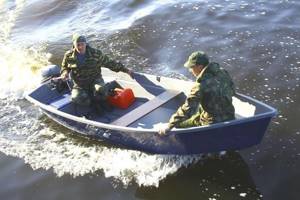
It is advisable to take a boat with a flat bottom and comfortable benches. To move around a body of water, such watercraft are equipped with gasoline engines with a power of 10-15 hp.
On a note! For vertical fishing for pike perch, it is optimal to use two boat motors at once - electric and gasoline. A low-power electric motor is used for slow, silent movement around a promising area. A gasoline engine with a power of more than 10 hp. necessary for quickly moving from one fishing spot to another, quickly returning to the shore in case of heavy rain or big waves.
We recommend reading: Detailed description of dace fish
Important. The use of inflatable boats in vertical fishing is less preferable since they are less stable in waves and strong currents. In addition, inflatable boats are easily pierced by sharp bait hooks.
Catching pike perch with a vertical jig from a boat
Catching deep-sea predators with a spinning rod is certainly one of the most popular, exciting and effective fishing methods. The simplest, most accessible and well-known is jig fishing, but classic jig does not always bring success. Having correctly selected and presented the bait, with a jig you can quickly and effectively fish large and varied areas of the bottom - edges, slopes, channels, holes, underwater mounds.
Much has been written and rewritten about the technique and tactics of this fishing, but there are a number of non-standard situations in which even experienced masters - “dzhigits”, who perfectly know the fishing methods and masterfully use the gear, do not immediately, easily and do not always find a solution. The most varied fishing conditions, sometimes changing over just a hundred-meter stretch of a reservoir, non-standard and inconvenient positions for predators in snags, under sharp vertical edges, in strong currents - all this seems to have already happened, but often even a universal and time-tested jig becomes useless.
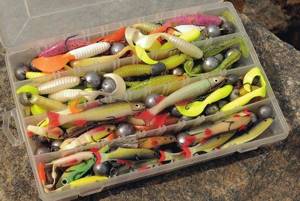
Many years of fishing experience in various regions of the country, in a variety of difficult and often extreme conditions, have allowed us to develop an approach that brings success where many other fishermen, after casting for 10–15 minutes, are forced to throw up their hands and change place.
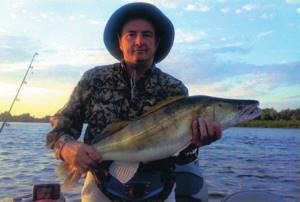
Several situations
Akhtuba.
The fishing area has a significant current. A relief anomaly was discovered - a sharp, almost vertical drop into a pit. According to the echo sounder, the fish is standing tightly and precisely on the dump. A meter to the left, a meter to the right - empty. Trying to fish a point using the standard jig technique, I encountered an obvious problem - a head picked up by the stream, even weighing 60 g, sweeps over the fishing zone in half a second. The postings did not work. The decision did not come immediately, but it did come! What if you try to catch it with a plumb raft? No sooner said than done. The boat follows the stream, the bait works vertically above the bottom.
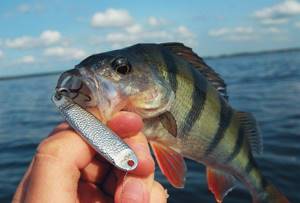
There is some drift, but not the same as during a throw. I pass over the dump - blow! The first pike perch stubbornly shakes its head. Second run - second pike perch! On the third pass - another one, and everything is literally at the same point. Subsequently, more than once or twice in similar situations, switching from the jig technique to vertical lures, I achieved success.
Classic jig baits did not always work. Often, “iron” worked much better - yukkers, jigs, cut tubes. Such baits caught not only predators, but also all kinds of peaceful fish. He notes the diversity and abundance of bycatch during vertical hunting in his book “Russian Spinning”. Sheer trolling≫ and Vladimir Lavrov is a great connoisseur and specialist of this fishing method. Fishing on the flat, flat bottom of a river reach—the feeding table—is another situation in which a standard jig often becomes ineffective.
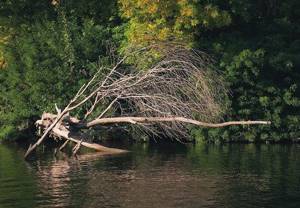
On such reaches with a pronounced current and a hard sandy-clayey or rocky-pebble bottom, whitefish often graze, and their fanged pike perch graze. It is impossible to perform a classic jig in such a place. A flat bottom and current reduce the step to “no”, and at best the result is dragging, and this does not always seduce the pike perch. One of the few baits that works successfully in this mode is a primitive homemade Christmas tree decoration that rustles and scrapes its paws along the bottom when dragged. And sometimes it is precisely this non-standard behavior that provokes the pike perch.
Another and, perhaps, optimal fishing option in such conditions is to raft with a vertical lure along the reach. This method is widely used by fishermen on both the Oka and Don. From them I learned the techniques and tactics of summer sheer trolling on the river. Both classic winter vertical spoons and even balancers, as well as standard jig baits - vibrotails, twisters, weighted streamers, can be used as bait.
A rig with live bait or a simple rig with a drop-shaped weight at the bottom and a side leash - a branch with a single hook - works flawlessly, on which small live bait - bleak, gudgeon - is attached. From time immemorial, on the Oka, such fishing has been called “with a pin” (apparently, from the origin of the first hooks for this technique). More than once or twice before my eyes, local fishermen completely caught seasoned and venerable “dzhigits” while using live bait.
Dniester River , Soroki village, Moldova. Powerful current, rocky bottom. At the bottom there are not some pebbles, but real boulders. With any jig wiring, a little gape - a dead hook. The load gets stuck between the stones to death. Only two options helped the fishing - a wire paternoster with a leg length of more than 30 cm and a white twister on a single hook attached to a lead, as well as reciprocal lure, or more precisely - fishing with a plumb raft on a large jig with baited fry. Tapping the rocky bottom with it and lowering the tasty bait right under the pike perch’s nose, my local partner and I had a great time catching pike perch. Subsequently, many times a large jig with a bait of fry, working in a plumb line, saved me from being bitless in the summer and even in the winter.

On the Don and its tributary - the Bityug River - I somehow had to face the most difficult conditions for catching pike perch. The predator stood in a snag under trees that had fallen into the water near washed-out steep ravines on the very current. Ten casts with a jig - 9 hooks. And this is with the use of offset machines and other most “non-clinging” equipment. Having pretty much thinned out the box of bait, I take the boat into the very snags and tie it from the bow to a branch sticking out of the water. I try to fish vertically from the stern using a spoon with a single hard-soldered hook, from under the turnout located below. The first strike on the lure is already on the dive. And off we go!
Where fishing with a jig was simply impossible, vertical lure brought a lot of fun and an excellent catch. At the same time, I tore off only three baits during the entire fishing trip... During another fishing trip in the vastness of the Rybinsk water storage facility, my friend and I discovered a vast area of flooded snags. At a depth of about 8 m, the echo sounder showed a forest standing almost to its full height. And in this forest there are fish of all sizes and colors. However, how can you catch here? I try the foam rubber with the double pressed.
Five wires were empty - only blows on trees, on the sixth there was a dead hook, apparently the head had climbed into some crevice. A friend is chasing a vibrating tail on an offset hook - the result is not much better - one perch and one blow from someone. It is well known that the Rybinsk predator does not favor jig baits, often preferring iron.
I take out the good old castmaster from the box and a second one for my partner. Using the echo sounder, we take the boat to a small “edge” among the snags, lower the bait to the bottom and throw it up with a sharp jerk. The bait falls with trembling and yaw. This kind of game has been tested, and more than one pike perch has become its captive. Seryoga’s first blow is a good pike perch, about two and a half kilograms.
My next one is a little smaller, but it hits like a hammer - I like the lure! It was great fishing! During the evening we caught a dozen and a half pike perch, collecting them like mushrooms from the edges of a flooded forest. Many predators, including large perch, often hunt in the water column. I have encountered this behavior more than once in the deep lakes of Karelia and in reservoirs near Moscow. But how to fish if there are 12, or even 20 m below you, and the fish stays at 3–5 m? The best way is, again, sheer lure.
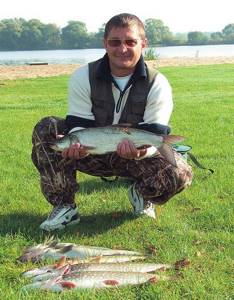
So in Karelia on Maslozero , having discovered a flock of vendace on an echo sounder at a depth of 6–7 m (which, God willing, is one tenth of the total depth at a given point), my friends and I always used vertical lures, using thin gliding winter lures. At the same time, our trophies included not only large perch, but also deep-sea palya that went hunting.
"Moscow Sea" . My friend and I are fishing for perch. He knows the reservoir very well. We are standing opposite a clay cliff. The depth drops almost vertically from 4 to 12–16 m, and somewhere in the middle of the slope hardened perches graze. A compact jig, rolling down the slope, slowly goes into the depths. And during the time there is a large perch. The fishing efficiency is low - out of 20–30 fishing trips, only one or two result in a bite. But the fish you come across are good - from half a kilo and larger. By lunchtime the bite subsides. In the evening, returning to the point, we decide to try fishing vertically.
Taking advantage of the calm, we position the boat exactly above the dump. We will use classic winter perch spoons as bait. Fishing horizon after horizon, we increase the depth. At the level of 6.5–7 m, both have simultaneous bites. A pair of redfin humpback whales in a boat - a start has been made! I won’t spend too much time describing the delights of that unforgettable fishing, I’ll just say that the crazy perch safari lasted until sunset, and the largest perch was 37 cm long. And not a single bite from the bottom!
Old peat quarries filled with water near the village of Kadanok . They are well known to many Moscow spinning players. There is some good pike fishing here and some good perch. However, few people know that large seasoned perch in these places are best caught in the narrow deep channels connecting the quarries. The striped ones stand in the roots of flooded willow bushes at a depth of 2–4 m.
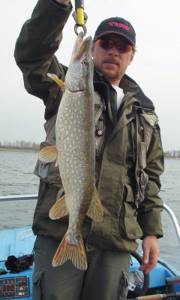
Fishing with a spinning rod is extremely inconvenient - the channels are narrow, the areas of open water are tiny, and there are also snags. Only vertical trolling using a small twister or a vibrating cicada can reward an excellent catch of humpback whales, sometimes taken from a single window measuring two by two meters.
Mysterious and enigmatic rivers of Meshchera near Moscow - Buzha and Pra . At every turn there are impassable snags, rubble, and inversions. Seasoned pike, perch and ide are kept in snags. There are only two ways to catch fish in such supports - either using live bait with a float, or using a plumb line using a spoon or the same live bait. Often you have to catch in windows among snags. Slowly lowering the bait into the very wilds, such fishing requires the use of a strong cord, which allows, when hooked, to straighten the hook and literally rip the fish out of the snags when biting.
Seliger. The bay with depths from 4 to 6 m is overgrown with water lilies. Picturesque plants with powerful rhizomes stand in a checkerboard pattern, turning jig fishing into torture—retrieving is impossible. But it is there, in the very depths of the roots, that seasoned pikes stand. Plumb fishing again helped to adapt to non-standard fishing conditions. In the windows among the water lilies, the most ordinary Atom type vibrating device worked perfectly.

Don't be afraid to experiment with baits (artificial and natural) and rigs. Carefully observe local fishermen - their experience can be invaluable
Astrakhan region , indigenous Volga. Numerous predators are found in its vastness. However, fishing depths reaching 15, 20, and 30 m, combined with a powerful current, seriously complicate the jigging technique. Heads of 60 and even 80 g sometimes do not penetrate the bottom! And again, sheer flashing with the alloy helps. At the same time, I recommend using classic lead jigs, designed for fishing in the deep sea, instead of jig baits. Even a 150-gram jig perfectly imitates small fish - the usual food of pike-perch, while a 150-gram jig head already looks like a small billiard ball. The plumb depths are penetrated more easily and easily. By directing the boat downstream along an underwater slope or channel, you can fish large areas, catching seasoned pike perch, pike and even catfish from depths inaccessible to the “horsemen”.
Catching catfish
Catching catfish with a vertical lure is a special matter. This predator often stays at the very depths - in holes along the riverbed. There are, perhaps, only two ways to effectively catch the baleen at depths of more than 15 m - bottom tackle or vertical lures. Long-term practice of Lower Volga fishing clearly demonstrates: vertical fishing is one of the most effective ways of hunting catfish. Of all the possible baits for catfish, yellow and white large twisters and vibrotails work excellently. The weight of the head can reach 80 or 100 g. It does not scare the catfish. Bright heavy jigs performed well. In the most sluggish bite, a rig with live bait or a frog always helps. The classic hunting spot is a deep-sea riverbed dump or a stepped dump into a deep hole.
Tackle
Having used vertical lures in open water for many years in combination with jigs and as an independent method of fishing, I never cease to be amazed at the versatility and effectiveness of this method! Without exception, all predators - from pike perch, bersh, large perch, pike to ide, asp, catfish, and even salmon and taimen were caught by this method over years of practice.
Moreover, large bream, silver carp and grass carp are very often in the by-catch, and they grab the bait, and do not turn purple!!! I caught carp twice! And on the Oka River I caught a sterlet once. The ability to fish in a wide variety of places, often inaccessible to other methods, the ability to purposefully catch large, bottom-dwelling fish, extensive experimentation with baits - all this puts vertical lures on a par with such exciting fishing methods as jigs and spinning in general.
Today, when I go fishing, I always take with me gear that allows me to fish with both a jig and a plumb line. The method of trial, error and experimentation allowed it to be fully optimized. So, you will need a rigid rod with a fast action and a test corresponding to the weight of the baits used. In the middle zone, I often use Zenaq Snipe 2.13 long with dough from 4 to 21 g. On Akhtuba - Restaffine Monster Edition 83 N with dough 10-45 g, on Mother Volga - Restaffine Monster Platinum 300 N with dough 14-56 g. For targeted hunting for catfish - Grand Wave - X 962 with dough up to 150 g from Daiwa.
The optimal reel, which allows you to combine two fishing methods, quickly and conveniently control the gear, track the sharply changing bottom, and perform an instant hook on the first strike and touch - the classic inertial one. The most powerful direct pull, the ability to use thick cords that allow you to extend the hooks on the hooks, the maximum strength, reliability and sensitivity of a high-quality inertial reel make it absolutely indispensable for connoisseurs of jigging and vertical fishing. Until recently, finding a good inertia was not easy. In the best case, you had to use English wiring coils or order a coil individually from artisans.
Quite recently, a new Russian reel “Nelma”, produced by the company “Russnast”, appeared on the market. The reel fully meets the highest modern requirements both in terms of throwability and versatility; moreover, it has a minimal moment of inertia and smooth running of the drum mounted on two sealed ball bearings, which allows the reel to be used perfectly in jig fishing, starting with lures weighing 6–8 G.
Having caught the new product, this season I adopted the “Nelma” as the main reel for both methods of deep-sea fishing. A variety of baits can be used for vertical fishing. We have already considered most of them in the process of describing fishing. Surely, already on your second or third fishing trip you will be able to independently select the most catchy and convenient options from the described arsenal. I can only advise once again - don’t be afraid to experiment with baits and equipment.
If, in addition to predators, you are also interested in peaceful fish, try placing a small twister on the hook or secure it by attaching it to a single hook on a side lead. Bream, silver bream, ide and many other river and lake inhabitants will pay for their curiosity.
The most powerful direct pull, the ability to use thick cords that allow you to straighten the hooks on the hooks, maximum strength, reliability, and sensitivity make the inertial reel absolutely indispensable for vertical fishing.
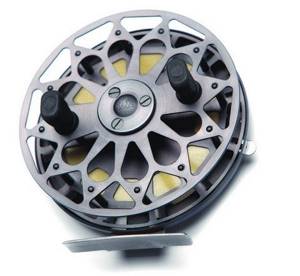
Closely monitor the activities of local fishermen. Their experience can be invaluable! Never give up the use of natural baits - live bait, frog, “cutting”, a bunch of worms can often not only save you from being bitless, but also turn fishing from a dreary and mournful process of torture into an exciting and exciting one.
See you fishing!
Expert of the Fishing Travel Club Alexey Chernushenko
Where and when is it better to catch pike perch in a plumb line?
You can catch the fanged inhabitant of river holes and pools throughout the open water season. However, such fishing is most productive in the fall, when pike perch actively feeds on the eve of winter, fattening up its fat.
The most successful fishing for pike perch from a boat takes place in places with bottom anomalies:
- Sharp drops into depth;
- The lower edges of the slopes;
- Lumps and navels;
- Debris of snags;
- Boulders lying at the bottom;
- Channel ditches within reaches;
- Wintering pits;
- Whirlpools near bridges and hydroelectric dams;
- Extensive deep-water “tables” of large reservoirs.
Unlike summer, in autumn pike perch is more actively caught not at night, but throughout the daylight hours, although night fishing more often brings trophy fish.
